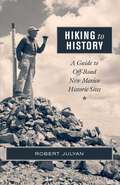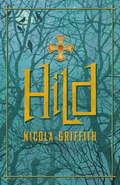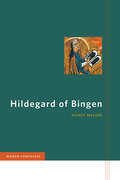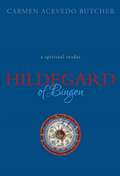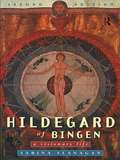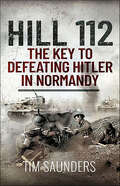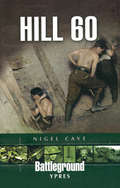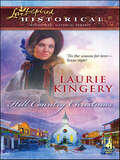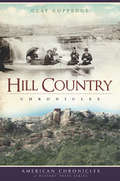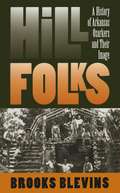- Table View
- List View
Hiking through History New England: Exploring the Region's Past by Trail (Hiking Through History)
by Johnny MolloyWhether you're a curious tourist or a local history buff, this guide contains all the tools you'll need to explore New England's history on your hikes. Each of the 40 featured hikes comes with helpful maps and directions, as well as a carefully researched impression of the trail, and a comprehensive guide to the area's natural and human history.
Hiking through History San Francisco Bay Area: Exploring the Region's Past by Trail (Hiking Through History)
by Tracy SalcedoImagine hiking along a wooded trail near San Francisco and stumbling upon the stone foundation of a crumbled building, the wooden slats of the walls caved in, the ironwork of the hinges still dangling on the burned out door. This discovery piques your interest—what is this? What&’s its significance? How can you find out? Enter Hiking through History San Francisco Bay Area: Exploring the Region's Past by Trail. Make no mistake—this is a hiking book first and foremost, complete with rich photos and detailed maps, but with added extras and sidebars detailing enough historical information to satisfy every curiosity along the way.
Hiking through History Washington: Exploring the Evergreen State's Past by Trail (Hiking Through History)
by Nathan Barnes Jeremy BarnesA beautiful, full-color guidebook to more than 40 of the best hikes following the history of the state of Washington.
Hiking to History: A Guide to Off-Road New Mexico Historic Sites
by Robert JulyanWith more than 13,000 years of human habitation, New Mexico offers a wealth of historic sites located on vast tracts of land well off the beaten path. As author Robert Julyan observes, not much history has been made from a speeding car, and locations that have to be reached on foot are almost always less altered by parking lots, visitor centers, roadways, or traffic noise. Written for both outdoor enthusiasts and vicarious travelers, Hiking to History describes the historical significance behind these publically accessible sites and includes GPS coordinates to enable readers to find each place. Ranging from the state&’s principal Civil War battlefield at Glorieta to the dirt road where a broken wagon wheel led two young artists to settle in Taos in 1898, the scenes provide an up-close experience of the state&’s remarkable past.
Hild: A Novel
by Nicola GriffithA brilliant, lush, sweeping historical novel about the rise of the most powerful woman of the early Middle Ages: Hild. In seventh-century Britain, small kingdoms are merging, frequently and violently. A new religion is coming ashore; the old gods are struggling, their priests worrying. Hild is the king's youngest niece, and she has a glimmering mind and a natural, noble authority. She will become a fascinating woman and one of the pivotal figures of the Middle Ages: Saint Hilda of Whitby. But now she has only the powerful curiosity of a bright child, a will of adamant, and a way of seeing the world-of studying nature, of matching cause with effect, of observing her surroundings closely and predicting what will happen next--that can seem uncanny, even supernatural, to those around her. Her uncle, Edwin of Northumbria, plots to become overking of the Angles, ruthlessly using every tool at his disposal: blood, bribery, belief. Hild establishes a place for herself at his side as the king's seer. And she is indispensable--unless she should ever lead the king astray. The stakes are life and death: for Hild, for her family, for her loved ones, and for the increasing numbers who seek the protection of the strange girl who can read the world and see the future. Hild is a young woman at the heart of the violence, subtlety, and mysticism of the early Middle Ages--all of it brilliantly and accurately evoked by Nicola Griffith's luminous prose. Working from what little historical record is extant, Griffith has brought a beautiful, brutal world to vivid, absorbing life.
Hild: A Novel
by Nicola Griffith'Truly, truly remarkable' Karen Joy Fowler'Extraordinary...resonates to many of the same chords as Beowulf, the legends of King Arthur, The Lord of the Rings, and Game of Thrones' Neal Stephenson'You are a prophet and seer with the brightest mind in an age. Your blood is that of the man who should have been king ...That's what the king and his lords see. And they will kill you, one day'In seventh century Britain, a new religion is coming ashore while small kingdoms are merging, frequently and violently. Hild is the king's youngest niece, with a glittering mind and natural authority, She is destined to become one of the pivotal figures of the early Middle Ages: Saint Hilda of Whitby. But for now she has only the powerful curiosity of a child and the precarious advantage of a plotting uncle, Edwin of Northumbria, who will stop at nothing to beome king of the Angles. Hild establishes herself at her uncle's side as the king's seer, and becomes indispensable - as long as all goes well for Edwin. The stakes are high - life and death - for Hild, her family and for all those who seek the protection of this strange girl who seems to see the future. In this vivid, utterly compelling novel, Nicola Griffith has brought the Early Middle Ages to life in an extraordinary act of alchemy, transporting the reader into a mesmerising, unforgettable world.
Hildegard of Bingen (Women Composers)
by Honey MeconiA Renaissance woman long before the Renaissance, the visionary Hildegard of Bingen (1098-1179) corresponded with Europe's elite, founded and led a noted women's religious community, and wrote on topics ranging from theology to natural history. Yet we know her best as Western music's most accomplished early composer, responsible for a wealth of musical creations for her fellow monastics. Honey Meconi draws on her own experience as a scholar and performer of Hildegard's music to explore the life and work of this foundational figure. Combining historical detail with musical analysis, Meconi delves into Hildegard's mastery of plainchant, her innovative musical drama, and her voluminous writings. Hildegard's distinctive musical style still excites modern listeners through wide-ranging, sinuous melodies set to her own evocative poetry. Together with her passionate religious texts, her music reveals a holistic understanding of the medieval world still relevant to today's readers.
Hildegard of Bingen and Musical Reception
by Jennifer BainSince her death in 1179, Hildegard of Bingen has commanded attention in every century. In this book Jennifer Bain traces the historical reception of Hildegard, focusing particularly on the moment in the modern era when she began to be considered as a composer. Bain examines how the activities of clergy in nineteenth-century Eibingen resulted in increased veneration of Hildegard, an authentication of her relics, and a rediscovery of her music. The book goes on to situate the emergence of Hildegard's music both within the French chant restoration movement driven by Solesmes and the German chant revival supported by Cecilianism, the German movement to reform Church music more generally. Engaging with the complex political and religious environment in German speaking areas, Bain places the more recent Anglophone revival of Hildegard's music in a broader historical perspective and reveals the important intersections amongst local devotion, popular culture, and intellectual activities.
Hildegard of Bingen: A Spiritual Reader
by Carmen Acevedo Butcher"Humanity, take a good look at yourself. Inside, you've got heaven and earth, and all of creation. You're a world – everything is hidden in you." –Hildegard of Bingen She was a Benedictine abbess, artist, composer, dietician, naturalist, poet, travelling preacher, mystic, and political consultant. She was a self-doubter with acute certainty in a merciful and mysterious God; a gifted healer who suffered from illness her whole life. Meet the incomparable Hildegard of Bingen. Nourishing, challenging, and idea-bursting, her writings will stir and awaken your soul. This essential reader captures the vibrant spirit and intelligence of Hildegard with selections from her songs, theological texts, liturgical music, and letters. Combined with an introduction to Hildegard's life and era, a map of Hildegard's Germany, chronology, and a thorough bibliography/discography, Hildegard of Bingen provides the ideal introduction to the thought of this fascinating medieval mystic.
Hildegard of Bingen: A Visionary Life
by Sabina FlanaganDrawing on contemporary sources, the text unfolds Hildegard's life from the time of her entrance into an anchoress's cell--where a woman would remain in pious isolation--to her death as a famed visionary and writer, abbess and confidante of popes and kings, more than seventy years later. Against this background the author explores Hildegard's vast creative work, encompassing theology, medicine, natural history, poetry, and music.
Hildegard of Bingen: Selected Writings
by Mark Atherton Hildegard Of BingenBenedictine nun, poet and musician, Hildegard of Bingen (1098-1179) was one of the most remarkable figures of the Middle Ages. She undertook preaching tours throughout the German empire at the age of sixty, and was consulted not only by her religious contemporaries but also by kings and emperors, yet it is largely for her apocalyptic and mystical writings that she is remembered. This volume includes selections from her three visionary works, her treatises on medicine and the natural world, her devotional songs, and fascinating letters to prominent figures of her time. Dealing with such eternal subjects as the relationship between humans and nature, and men and women, Hildegard's works show her to be a wide-ranging thinker who created such fresh, startling images and ideas that her writings have been compared to Dante and Blake.
Hildegard von Bingen: Versione per studenti e docenti (Le leggendarie donne della storia mondiale #11)
by Laurel A. RockefellerArmata di penna e calamaio, riscrisse la storia del cristianesimo medievale. Hildegard von Bingen non era destinata a passare alla storia. Decima figlia di uno del vassalli del conte von Sponheim, era stata donata dai genitori al monastero di Disibodenberg in segno di gratitudine a Dio, ma soprattutto perché, a causa delle sue visioni, sarebbe stato difficile darla in sposa ad un buon partito. Quando succedette a Jutta von Sponheim nel ruolo di Magistra e priora di Disibodenberg, mantenere il segreto riguardo alle sue visioni divenne impossibile. Quanto accadde in seguito, sconvolse non solo la vita monastica per le donne del suo ordine, ma l'intera storia mondiale. Scopri la storia della scrittrice più prolifica del Medioevo, la leggendaria Hildegard von Bingen. L'edizione per studenti e docenti è corredata da domande d'approfondimento alla fine di ogni capitolo.
Hill 112: The Key to defeating Hitler in Normandy
by Tim Saunders‘He who holds Hill 112 holds Normandy’ seemed an unlikely maxim when the hill is viewed from a distance, but on reaching its plateau, the vistas unfold in every direction across a huge swath of Normandy. For the Germans it was their vital defensive ground, but for the British it was an essential steppingstone en route to the River Orne and access to the open country south to Falaise. The Hitlerjugend SS Panzer Division lost Hill 112 to 4th armored Brigade when the Scots captured the Tourmauville Bridge intact, but the essence of Hill 112’s tactical problem soon became clear. It was impossible for armor to survive on its broad plateau, while the infantry could only hold the skeletal orchards and woods at the cost of crushing casualties. With II SS Panzer Corps preparing to attack the British, the toe hold was given up and 11th armored Division was left holding a bridgehead across the River Odon. Ten days later, 43rd Wessex Division was ordered to resume the advance to the Orne with Hill 112 its first objective. As the west countrymen and tanks rose to advance, they met withering fire from the stronghold that Hill 112 had become. The scene was set for one of the grimmest battles of the campaign. For six weeks from the end of June into August, when the Allied advances finally gained momentum, Hill 112 was far too important to let the opposition hold and exploit it. Consequently, it was regularly shelled and mortared, and shrouded with smoke and dust, while soldiers of both sides clung to their respective rims of the plateau. By the end, Hill 112 had developed a reputation as evil as that of any spot on the First World War’s Western Front.
Hill 488
by Charles W. Sasser Ray HildrethFor some, Hill 488 was just another landmark in the jungles of Vietnam. For the eighteen men of Charlie Company, it was a last stand—this is the stirring combat memoir written by Ray Hildreth, one of the unit's survivors.On June 13, 1966, men of the 1st Recon Battalion, 1st Marine Division were stationed on Hill 488. Before the week was over, they would fight the battle that would make them the most highly decorated small unit in the entire history of the U.S. military, winning a Congressional Medal of Honor, four Navy Crosses, thirteen Silver Stars, and eighteen Purple Hearts—some of them posthumously. During the early evening of June 15, a battalion of hardened North Vietnamese regulars and Viet Cong—outnumbering the Americans 25-to-1—threw everything they had at the sixteen Marines and two Navy corpsmen for the rest of that terror-filled night. Every man who held the hill was either killed or wounded defending the ground with unbelievable courage and unflagging determination—even as reinforcements were on the way. All they had to do was make it until dawn...
Hill 60: Ypres (Battleground Ypres)
by Nigel CaveThe shell-ravaged landscape of Hill 60, some three miles to the south east of Ypres, conceals beneath it a labyrinth of tunnels and underground workings. This small area saw horrendous fighting in the early years of the war as the British and Germans struggled to control its dominant view over Ypres.
Hill Country Cattleman
by Laurie KingeryA Match Made In TexasTo escape a scandal in England, Violet Brookfield is sent to her brother's ranch in Texas. Soon she discovers that the vibrant new world and rugged trail boss Raleigh Masterson are perfect material for the Western she's writing. And when her time is up, she'll return to the nobleman she left behind.Violet is the most elegant female ever to set foot in Simpson Creek, and Raleigh is sure she'll never stay. He has no business falling for the beautiful aristocrat. But soon Violet makes a place for herself in the Hill Country-and in his heart. Now if only he can convince her that she belongs there forever....
Hill Country Christmas
by Laurie KingeryHoliday HeiressOvernight, Delia Keller went from penniless preacher's granddaughter to rich young heiress. She's determined to use her money to find the security she's always lacked. And building herself a new house by Christmas is her first priority. But handsome Jude Tucker is challenging her plans and her heart....The former Civil War chaplain hasn't felt peace in a very long time, and he has a hard time letting go of his past. But as Jude gets to know the spirited Delia, he longs to show her what true Christmas joy means. In the rugged Texas Hill Country, he'll reach for a miracle to restore his faith...and give Delia his love for all seasons.
Hill Country Christmas & Her Captain's Heart: An Anthology
by Lyn Cote Laurie KingeryTwo inspiring stories of determination, courage…and loveHill Country ChristmasIn the rugged Texas Hill Country, Delia Keller went from penniless preacher’s granddaughter to rich young heiress. She’s determined to use her money to find the security she’s always lacked, and build herself a new house by Christmas. Former Civil War chaplain Jude Tucker longs to show her what true Christmas joy means. Can he restore his own faith and give Delia his love for all seasons?Her Captain’s HeartIdealistic schoolteacher Verity Hardy believes nothing is impossible. The lovely widow is certain teaching freed slaves in a Virginia town torn apart by the Civil War will help heal bitterness and old wounds. However, she’s finding that the school’s cynical builder, former Union captain Matthew Ritter, has little faith in her plan—or anything else. But Verity’s spirit and courage inspire him to fight for what he believes in…
Hill Country Chronicles
by Clay CoppedgeTexas Hill Country is a rugged and hilly area of central Texas known for its food, architecture and unique melting pot of Spanish and European settlers. The area's rich history is filled with quirky and fascinating tales about this landscape and the animals and people who have called it home. Clay Coppedge has been gathering Texas stories for over thirty years. This collection of his favorite columns includes his best Texas-sized stories on Hill Country history. From the legend of Llano's Enchanted Rock and the true story of Jim Bowie's famous knife to one rancher's attempt at bringing reindeer to the hottest area of the country and an oilman's search for Bigfoot, Hill Country Chronicles has them all and more.
Hill Country Courtship
by Laurie KingeryA Baby of Her Own Maude Harkey is resigned to a loveless life until a baby is born-and orphaned-at her boardinghouse home. She'll never be a wife...but she can still be a mother. Yet a boardinghouse is no place for a newborn. Enter Jonas MacLaren-a handsome, exasperating rancher with an offer too good to refuse. Jonas can handle running a ranch-but handling his cantankerous mother is another matter. Maude matches his mother's stubbornness so she'll be a perfect live-in companion. But she's there for his mother, not for him. He'll just have to keep his wounded heart closed to her beauty, her humor, her warmth and strength-and her irresistibly adorable baby. Brides of Simpson Creek: Small-town Texas spinsters find love with mail-order grooms!
Hill Country Hindsights: Stories from a Simpler Time (American Chronicles)
by Michael BarrEncounter fascinating characters and forgotten stories from the Texas Hill Country's past, before the crowds and amenities made life complicated. Settled by German immigrants in the 1840s, Fredericksburg's corner of the Texas Hill Country bustles with the trendy energy of an international tourist destination. But there was a time not long ago when the quiet community remained off the beaten path, even if it continued to draw in luminaries like O. Henry, Buck Taylor and Bob Hope. A working knowledge of Town Creek German wasn't necessary, but it sure came in handy. From the White Elephant Saloon to the 87 Drive-In, Michael Barr tours the bygone byways of the Hill Country, showcasing the heritage that predates the overbooked wine tours and vacation rentals.
Hill End: An Historic Australian Goldfields Landscape
by Alan MayneThe history of the Australian gold rushes is full of exaggeration: the First This, the Richest That, the Largest Something Else. Hill End unravels the myths surrounding the gold rushes in order to reveal the hidden histories of the Wiradjuri people, of the graziers and convicts who occupied the Wiradjuri lands, of the multicultural gold-boom community and of the subsistence community that endured for generations after the boom had passed. Hill End is perched high on the New South Wales Central Tablelands, some 300 kilometres north-west of Sydney. The Hill End Historic Site, which was proclaimed in 1967, is one of first cultural heritage sites to be reserved in Australia. This is a book that digs past Hill End's gold rush fa�ade into the lives of the people who lived through its history.
Hill Folks
by Brooks BlevinsThe Ozark region, located in northern Arkansas and southern Missouri, has long been the domain of the folklorist and the travel writer--a circumstance that has helped shroud its history in stereotype and misunderstanding. With Hill Folks, Brooks Blevins offers the first in-depth historical treatment of the Arkansas Ozarks. He traces the region's history from the early nineteenth century through the end of the twentieth century and, in the process, examines the creation and perpetuation of conflicting images of the area, mostly by non-Ozarkers.Covering a wide range of Ozark social life, Blevins examines the development of agriculture, the rise and fall of extractive industries, the settlement of the countryside and the decline of rural communities, in- and out-migration, and the emergence of the tourist industry in the region. His richly textured account demonstrates that the Arkansas Ozark region has never been as monolithic or homogenous as its chroniclers have suggested. From the earliest days of white settlement, Blevins says, distinct subregions within the area have followed their own unique patterns of historical and socioeconomic development. Hill Folks sketches a portrait of a place far more nuanced than the timeless arcadia pictured on travel brochures or the backward and deliberately unprogressive region depicted in stereotype.
Hill Man
by Janice Holt GilesRady Cromwell is a young man who has drive and determination that will see him through his life long. At age 12 he wants a gun a hunting dog, and a guitar. At 17 he has his eyes on a good farm and the widow who owns it. Though the book will take many twists and turns, he in the end is striving after something more.
Hill Towns of Italy
by Lucy Lilian NotesteinLucy Lilian Notestein’s Hill Towns of Italy is a lyrical and evocative exploration of Italy’s picturesque hilltop villages, capturing the charm, history, and cultural richness of these timeless landscapes. With keen observation and poetic prose, Notestein takes readers on a journey through the cobbled streets, ancient walls, and vibrant traditions that define these remarkable towns.From Tuscany’s rolling hills to the rugged regions of Umbria and beyond, the book offers vivid descriptions of the architecture, art, and daily life that make each town unique. Notestein weaves together historical anecdotes, local legends, and personal impressions to create an intimate portrait of these enchanting places. Readers will find themselves immersed in the beauty of medieval fortresses, sun-drenched piazzas, and the enduring rhythms of rural Italian life.More than a travelogue, Hill Towns of Italy delves into the cultural and historical significance of these towns, highlighting their role as centers of art, religion, and community over the centuries. Notestein’s deep appreciation for the region’s heritage and her ability to bring its people and places to life make this book a treasure for both armchair travelers and seasoned adventurers.Whether you are drawn to Italy’s storied past, its artistic treasures, or the simple beauty of its landscapes, Hill Towns of Italy offers a rich and rewarding glimpse into one of the world’s most captivating regions. This timeless work is a must-read for lovers of history, art, and travel.



